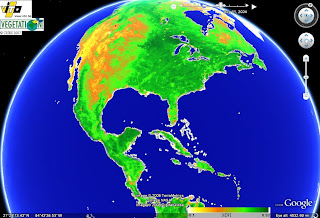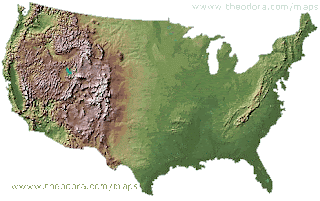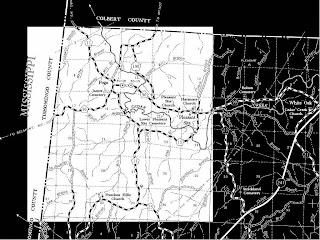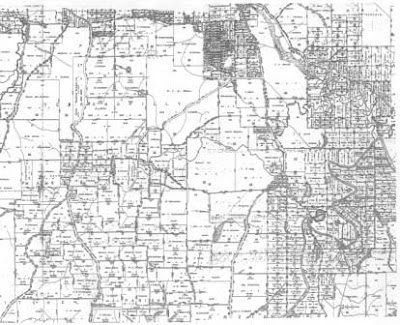 This KLM data from the VEGETATION program. It is remote sensing of "terrestrial vegetation cover...at the global level." The data is obtained through the VEGETATION1 and VEGETATION2 sensors aboard the SPOT4 and SPOT5 satellites. More information can be found at www.spot-vegitation.com. In using the KLM with Google Earth, One is able to review data from any point on the globe, as well as move through time samples to compare data over time.
This KLM data from the VEGETATION program. It is remote sensing of "terrestrial vegetation cover...at the global level." The data is obtained through the VEGETATION1 and VEGETATION2 sensors aboard the SPOT4 and SPOT5 satellites. More information can be found at www.spot-vegitation.com. In using the KLM with Google Earth, One is able to review data from any point on the globe, as well as move through time samples to compare data over time.
Thursday, June 26, 2008
KLM Remote Sensing/ Google Earth
 This KLM data from the VEGETATION program. It is remote sensing of "terrestrial vegetation cover...at the global level." The data is obtained through the VEGETATION1 and VEGETATION2 sensors aboard the SPOT4 and SPOT5 satellites. More information can be found at www.spot-vegitation.com. In using the KLM with Google Earth, One is able to review data from any point on the globe, as well as move through time samples to compare data over time.
This KLM data from the VEGETATION program. It is remote sensing of "terrestrial vegetation cover...at the global level." The data is obtained through the VEGETATION1 and VEGETATION2 sensors aboard the SPOT4 and SPOT5 satellites. More information can be found at www.spot-vegitation.com. In using the KLM with Google Earth, One is able to review data from any point on the globe, as well as move through time samples to compare data over time.
Wednesday, June 4, 2008
Hypsometric Map

This map uses a hypsometric color display to show elevation. In this case the darker green areas are closer to sea level with the progressively brown to tan to white areas marking higher to higher elevations. This map shows only the contiguous United states. In reality the slope continues under sea level to deep sea trenches. Maps that do show underwater topography usually use light blue to denote sea level with progressively darker shades of blue showing increasing depth.
The above image can be found at www.theodora.com/maps/new9/usa_elevation_map.gif
Public Land Survey System (PLSS) Map

The above shows the state of Alabama divided by the meridians and lines of the PLSS. Highlighted in blue is Franklin County. A larger scale look at Franklin County with PLSS divisions is below.

The above map shows Franklin County as a whole, divided by the PLSS system. We will look closer, below, at T6S, R15W. This means we are looking at portion of land 6 Townships south of the Base Line, and we are located in a land portion 15 sections west of Principal Meridian R.

As seen above, state and local borders do not necessarily align with the PLSS System. In particular the difference between the state border on the north from the PLSS system is reflective of the difference between the projections and the PLSS overlay.
All of the above maps can be found at http://www.rootsweb.ancestry.com/~alfrankl/landrecords.htm
Cadastral Map

The above map is a cadastral map for Logan City, Australia. This small-scale map (relative to the one below) obscures some fo the fine detail of a larger scale, but it does allow one to see the changes in relative size of properties in different areas of the city. It would seems there are areas of relatively high population density (or property density, anyway) in the right and top of the map.

On this larger scale map of the same region one can see finer detail, including measurements and boundaries for the individual properties, as well as owner names. It would seem that some sort of meets and bounds measuring system was utilized. I make this inference based on the use of the river on the right as a boundery. This would likey change over time (especially considering the meandering profile of the river).
The original can be found at http://www.logan.qld.gov.au/LCC/logan/history/publications/RidgetoRidgeRecollectionsfromWoodridgetoParkRidge.htm
Subscribe to:
Comments (Atom)